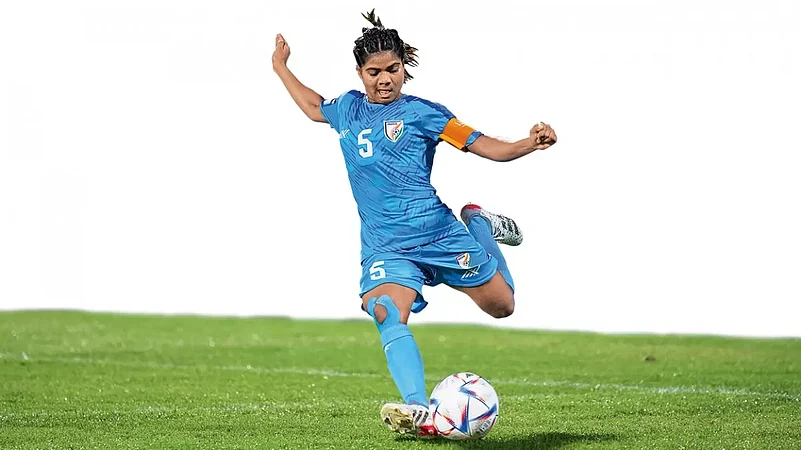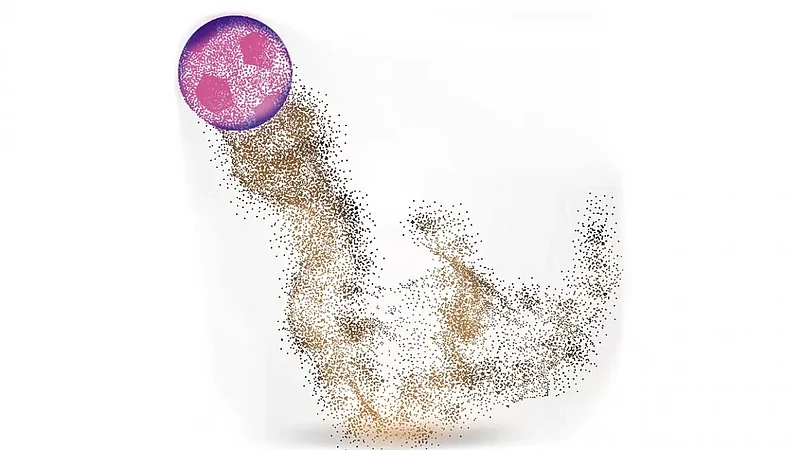Astam Oraon will be 17 soon. She has already rubbed shoulders with some of the most talented global peers in her sport, football. Oraon, the captain, along with six other Adivasi girls of Jharkhand, were part of the final squad of the Indian U-17 women’s football team in the FIFA U-17 Football World Cup in India in October 2022. The team became the first Indian football team (men or women) across all age groups to have played the group matches of the World Cup, a dream for most aspiring Indian footballers.
With her hair tied in a tight bun, Oraon waits hesitantly at the official residence of the chief minister of Jharkhand. It is mid-November 2022 and she is here not as a footballer but as a Young Ambassador, to deliver a talk in a UNICEF India workshop with child journalists and young school children in underdeveloped blocks and Maoist conflict-affected areas of the state trained in documenting case studies using audio-visual tools.
Advertisement
The interaction starts, her eyes light up when the chief minister greets her and then the young kids give her a standing ovation. She hears the youngsters out patiently and an hour later, she’s invited to speak. She begins slowly, composing her thoughts, and shares snippets of her tough childhood growing up in an Adivasi family, parents working as agricultural labourers in Banari village in Gumla district, over 100 km from the capital Ranchi. Her journey from a nondescript conflict zone to the district headquarters to enrol in the residential sports centre run by the state government and later to a regional Sports Authority of India (SAI) centre in Hazaribagh is one of grit and perseverance.
Advertisement
“I wasn’t allowed to play the game often by my family members and the local boys. But kicking the ball around in the dusty, sweltering summer heat, under the monsoon clouds and in misty foggy winters made me excited,” says Oraon, her eyes turning moist. She continues about her firsts in the world outside Gumla - her stay in Ranchi in the state government guest house, learning how to interact with the national team coach in English during the year-long camp and knowing names of small towns and villages of her fellow teammates from Chandigarh, Manipur, Odisha, West Bengal and Maharashtra. She shares her World Cup experience and speaks admiringly of the skills of her Brazilian counterparts, the power and stamina of her fellow footballers in the US national team and the mental toughness of the Moroccan girls.
“There is endless talent across our villages, particularly girls who don’t have that access just because we are born in a place with different points of view on how our lives as young girls and women should be led. We know the value of hardships, but not discipline. For me, for us and for all of you—the sky is indefinite. But we need to dare to dream and keep pushing ourselves,” Oraon signs off. The UNICEF state coordinator tells me that when they hosted a two-month speaking skills workshop for Oraon and six fellow players from Jharkhand in 2020, all they knew was to say their names.
Advertisement
Oraon and her fellow players remind me of Bhavani Munda, also an Adivasi woman player.
I first met Munda in 2011 in the sleepy hamlet of Kalchini, in the foothills of the Himalayas, in the region known as Dooars in the northern part of West Bengal. Born into a family of tea garden workers, Munda at that point was a celebrated woman football player in the region. When our old rickety Ambassador screeched to a halt in front of a tiny ramshackle teashop, I was introduced to Munda, who then had just lit the evening fire to heat milk for the customers. The shop, run with the help of one of her sisters, was set up to generate revenue to sustain a women’s football team called Dooars 11.
Advertisement
“I used to see my older cousin play with this round object and observe the grit and passion in his eyes. So, one day, I thought, even I should. Today, we are invited for special matches even in all-boys tournaments,” said Munda, then 28, diminutive but with steely eyes. Her journey started way back in 1994 when she and four other young girls started practising football in a region where aspiration had no takers. She did get selected for regional, and then state, team trials but could never travel due to lack of money.
In 2011, captained by Munda, Dooars 11 had Adivasis, Nepalese, Muslims, Buddhists and a few Hindu girls from small settlements of tea garden workers and labourers. All identified by Oraon, they had aggregated that evening in May near the tea stall, in the adjacent green patch. Over the successive years, I kept in touch with Munda and her soccer journey through Ramkumar Lama, a local social worker who worked hard to raise funds and get the girls access to training camps, jerseys and tournaments in Kolkata and other bigger towns. Later, in 2014, Munda received a global Sports Award - FEMINA Inspiring Sports Icon and her story was taken up by leading media outlets but they failed to drive any long term impact.
Advertisement
I spoke to Lama one evening in late December 2022, after a long hiatus. He finally managed to raise enough funds to start his own academy in October 2022 with 40 girls, the next generation of Dooars 11. Munda is now a key staff member of his academy, along with two local female coaches. “She’s doing fine. Young girls still look up to her. If not for Bhavani, local families would have never aspired to have dreamt of their daughters becoming footballers,” Lama says.

The likes of Oraon, Munda and numerous other girls, particularly from tribal communities across India have been a force to be reckoned with over the last few years, particularly in competitive and highly physical team sports like football, rugby and hockey, and archery, a traditional tribal customary practice. Across the dense forested villages of the erstwhile epicentre of Maoist conflict—Jungle Mahal covering the districts of West Midnapore, Jhargram, Purulia and Bankura—young Adivasi women can be seen practising dynamic moves, free kicks or one-touch passing. It’s a silent revolution, a transformation that other social initiatives might take years to achievein such remote, underdeveloped conflict zones. As one travels westwards and enters Jharkhand and southwards in Odisha, tribal girls are seen dribbling across the fields with their hockey sticks or juggling with footballs, or sharpening their aim with locally made bow and arrow sets.
Advertisement
Across various African, Latin American and Southeast Asian contexts, sports as a way of catalysing development has been experimented with by various governmental and non governmental agencies. A literature review of the famed Journal of Sport for Development and Peace (2007) collates almost 300 studies across continents where the efficacy of sports as a tactical device for promoting development schemes and resolving conflicts has been explored. Incidentally, sports is construed as a way of life in everyday tribal society, and Oraon, Munda and thousands like them are fighting against all odds, with very limited institutional support, lack of corporate and private investments, media attention. Yet they have ignited a spark of freedom, emancipation, empowerment and sporting excellence in these areas. Sports sociologists call it ‘the role model effect’.
Advertisement
The story of dispassionate development of the sporting ecosystem for women across India is true even in sporting powerhouse states like Manipur and Haryana. A recent study ‘Breaking Barriers for Women in Sports’, by the Bengaluru-based ‘Simply Sport’, revealed that 48 per cent of female athletes in Manipur travel over 10 kilometres to reach the nearest practice facility. The study, examining available public data, reported that Jharkhand and Odisha contributed to the largest increase in medals won by female athletes over the last two decades, both leaping into India’s Top 15 in terms of providing supportive facilities and a sporting ecosystem.
Advertisement
Over my decade-long travels across these remote hinterlands, the stories of these young women/adolescent girls are living examples of unhindered aspirations and daring dreams to break gender stereotypes. They challenge social norms and take up sport as a platform to express freedom, creativity and demonstrate the will to challenge patriarchal structures, hegemony and achieve new laurels. They carve a path towards dignified and respectful living and economic stability.
On 31 January, the All India Football Federation (AIFF) announced a 23-member squad of the U-20 Women’s National Team. From being the U-17 champion, Oraon led the Indian U20 colts in Dhaka on February 3. All of Oraon’s six teammates have been selected and they are super elated. They along with the other players know how much this will mean to the dreamy-eyed girls dribbling the ball in the forested and hilly patches of Jharkhand, Odisha, West Bengal, Manipur and elsewhere in India.
Advertisement
(This appeared in the print edition as "DRIBBLING Dreams")
(Views expressed are personal)
Arindam Banerjee is the founding partner of Policy and Development Advisory Group (PDAG) and is based in New Delhi




















